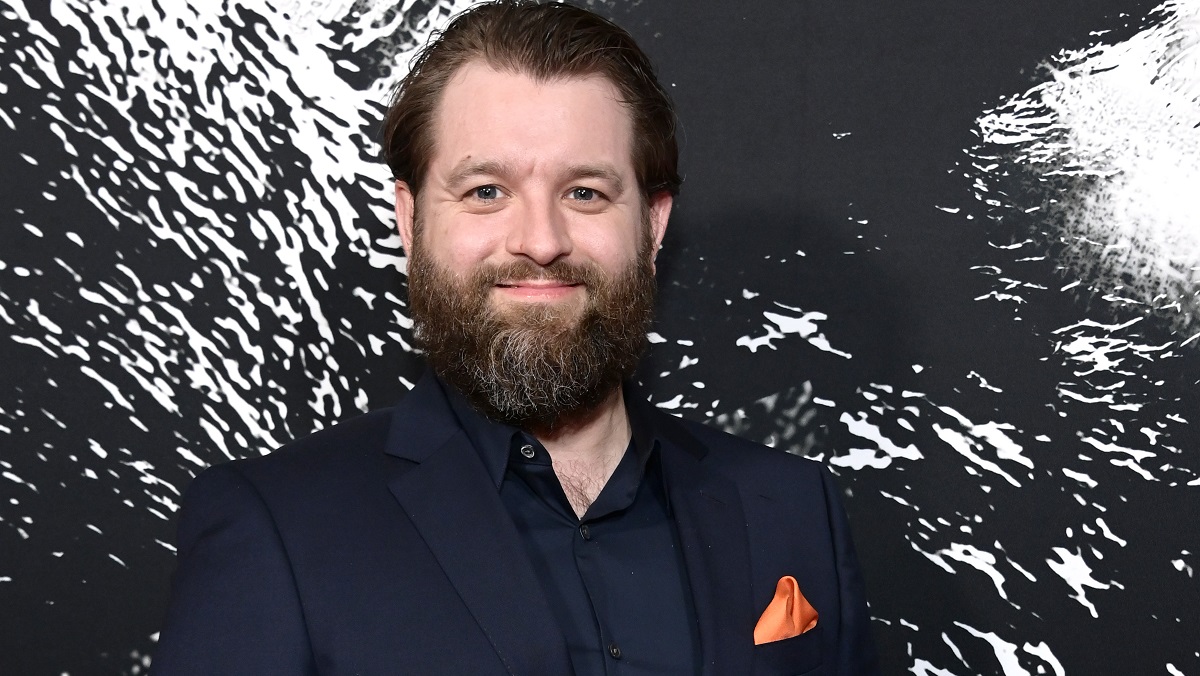No stranger to cult favorites following his contributions as either a writer or producer on such favorites as Netflix horror comedy The Babysitter, Lovecraftian nightmare Underwater, the delightful Love and Monsters, the combustible caper Spontaneous, and meme factory Cocaine Bear, filmmaker Brian Duffield is destined to add another one to the collection when No One Will Save You premieres on Hulu this Friday, Sept. 22.
The high concept hybrid of home invasion thriller and sci-fi spectacular finds Kaitlyn Dever’s Brynn living in solitude at her remote country house, only for all hell to break loose when visitors from beyond the stars descend on her sleepy existence and turn it upside down over the course of one chaotic night.
As well as being another phenomenal showcase for its star, writer and director Duffield once again displays his mastery of being subvert established genre norms and paint them in a coat of fresh and propulsive new paint. Make no mistake, No One Will Save You is sure to be a staple of the cosmic viewing diet for some time to come.
Ahead of the film’s release, We Got This Covered had the chance to speak to Duffield about No One Will Save You, how he honed in on a concept as ingenious as it is ambitious, working with Dever to develop a character that’s in virtually every frame, his designs on diving back into the world he created with Netflix animated series Skull Island and much more, which you can check out below.
I’m already fascinated to know where the core concept originated from, because one of my takeaways from the movie was that it’s a little bit Signs meets A Quiet Place meets Home Alone meets Die Hard, but it’s also a completely character and performance-driven movie that’s pretty experimental as well.
Brian Duffield: Yeah, I think it kind of stemmed from I had the character of Brynn separate from aliens for a long time. And then I had this alien movie that would start, you know, at the start of the movie as opposed to the end of the movie, or the home invasion element.
And then they, for whatever reason, got mashed together in my brain where I was like, “Oh, this would be an interesting way to explore this character of Brynn,” instead of just doing the indie drama version, to put her in a sci-fi epic. And I really liked the idea of when the world ends, or when there’s these natural disasters or whatever, it interrupts everyone, not just the cool people, or the people that could actually fight back.
And so something about having a character that was reckless and isolated, and going through a lot emotionally outside of the alien thing, felt like an interesting point of view going into a movie like this, and especially because it made her so physically incapable of fighting back. That felt like a really interesting dilemma for a character to go through.
It’s only your second feature, and presumably this is one that you weren’t going to let go of as a director under any circumstances? Because it’s easy to imagine the bare bones of the story would hypothetically be transformed into something completely different – and a lot more verbose, we’ll say – if it were to be handed over to somebody or someone else?
Brian Duffield: I think I’m essentially done handing things over entirely. So I think everything I write, if it’s an original thing, it’s either for me or I’ll hire the people to do it. But you know, this one from inception, it was always something I wanted to direct if they let me. And then thankfully, people let me.
Was it the sort of challenge you relished as a writer, filmmaker, and producer putting the film together both in pre-production, shooting, and post or did it ever feel daunting, knowing that it doesn’t even attempt to lean on or adhere to not even sci-fi conventions, but a lot of standard cinema conventions as well. Because for a movie of this scale and budget that feels big without being massive in terms of cost, the ambition is off the charts.
Brian Duffield: You know, it was definitely spooky. But I think that’s where I get really excited to work. Um, I mean, I would really love to do something that felt easy, at some point. But I think part of the fun of getting to direct movies is that it’s the fun and the nightmares that you don’t know if you’ll get to direct another one. And so there’s a little bit of like, leave it all on the field, and just really, really swing for it each time.
I don’t know, just for me, it just seems like it’s such an opportunity, and a rare opportunity to get to do what I’ve always wanted to do. And so I think not taking those swings and not leading with ambition, it would be coming from a place of fear. And that’s just not not how I want my career to go. I would really love to do like a very easy movie. I just don’t know what an easy movie would look like! But this one was definitely ambitious, but I think it was cool that once 20th Century got involved, there was never really anything from them about curbing the ambition.
So it just kind of felt like, like you said, we’re definitely going for a lot bigger movie than the budget, I would suggest. And then it felt like, you know, no one’s gonna give me $100 million to do this, they’re gonna give me this budget, which is way less than $100 million. And so I was like, “Well, fuck it, why not? Why not try and see what we can do?”
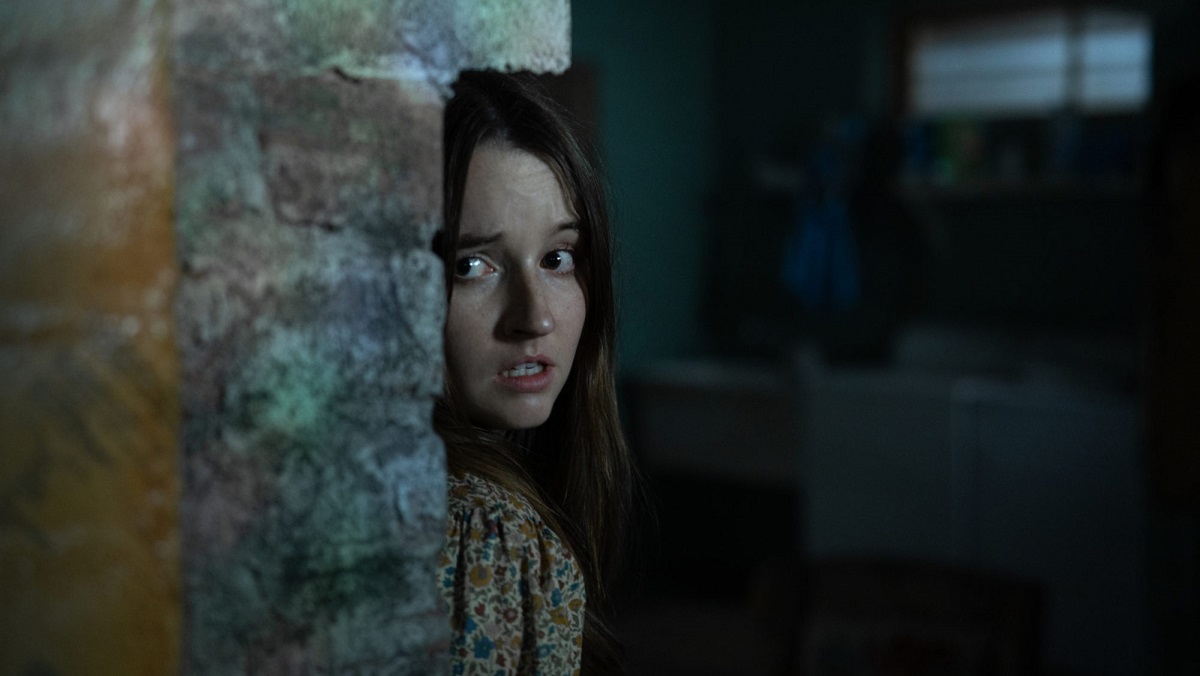
There’s less than 10 minutes of setup before all hell breaks loose, and even during that time there’s enough backstory for Brynn that audiences still have plenty of information to invest in the journey, but was that a difficult balance to strike in terms of both the script and the shoot to ensure that as much as the pace quickens right from the start and never lets up, the journey of the main character is always right at the very forefront of the story?
Brian Duffield: It’s probably easier in the script, just because you can write down specifically what people are supposed to take away from a given beat. And then, probably the hardest non-special effect part of the movie is definitely that opening chunk, where you’re trying to do a lot at once. You’re trying to set up this very interesting and complex character who on the offset looks kind of quirky and kooky, but is obviously not in that world once you kind of get to know what’s going on.
But then you’re trying to get everyone to be patient. Because, you know, everyone that’s clicking play knows that aliens are going to show up at some point. And so it’s kind of a little bit of a left-field curveball, where they are sitting through seven minutes of “this cute girl kind of going through her cute day.” And then and then when minute eight hits, everything goes to hell. Like you said, I was trying to give enough information that you felt like you understood some of her fears and struggles.
I think the likability thing was always very easy because Kaitlyn herself is so likable on screen, and in real life And then it was just getting your hooks in enough that you really cared about this character, so that when everything happens from minute eight on, you’re invested and you care about her, and you also understand that there’s some some pretty deep emotional mysteries to kind of unravel with her.
Kaitlyn manages to get put through the wringer and knock it out of the park in another incredible performance in a career that keeps filling up with them. What was the collaborative process between you guys as filmmaker and star to find the best possible version of what was on the page and deliver it on set, because it’s not an easy performance to give by any stretch especially with the limitations in the way that it’s told.
Brian Duffield: It’s a tough movie to have rehearsals for. Especially because she is so alone for so much. And so, instead of rehearsals, we just kind of chatted a bunch. And I think Kaitlyn wanted to go off and fill in the gaps on her own a little bit and internalize that that character, but we talked a lot in the weeks leading up to the shoot.
And when she signed on, of course, it was like… I think the fun of getting to work with Kaitlyn is how easy it is. And she comes extremely prepared, extremely specific. And so really, my job kind of just becomes modulating, and making sure I know where we’re coming from, and where we’re going. But even that, like she kind of already always knows, “This is where I fit in.” This is where I’m going, I need to do this to lead into that.
She’s such a gifted performer in terms of the nuance she’s able to convey, just with her face, and her physicality. And so I think it was something that she was really excited to dive into for that reason, that she could bring a lot of nuance to a very loud movie, and then also get to be so physical. So you know, she got to do all the training on wires and stunts and all the things that we let her do.
So I think she was really excited about creating a character that got to be so physical, but it seems like isn’t really an ass-kicker by any means. So that was really fun, I think challenging for her, but she makes a director’s life very easy, which is amazing for me!
For want of a better word, the aliens are very “classic” in their design, but they’ve got some surprises up their non-existent sleeves as well. Were you always writing with the intention of having that old school flavour in mind in terms of the look, and then flipping the script when it comes to their behaviour and hierarchy not necessarily being something audiences have seen before or are expecting?
Brian Duffield: Oh, absolutely, yeah. For us, it was always the starting off with the Grays. It’s a design that I’ve always loved. And then I’ve been missing it in the last however many years. It also just felt really great, you know, because we are introducing our aliens so much earlier than I think people are accustomed to.
Getting to have a design that kind of immediately, Kaitlyn and the audience would understand what they were looking at. Even just from the little glimpses that we get towards the start of the movie. It felt like a really great starting off point. And like you said, it allows us to build on that design, and to subvert the design and to add our little bonus features, and tricks up our nonexistent sleeves, as you said.
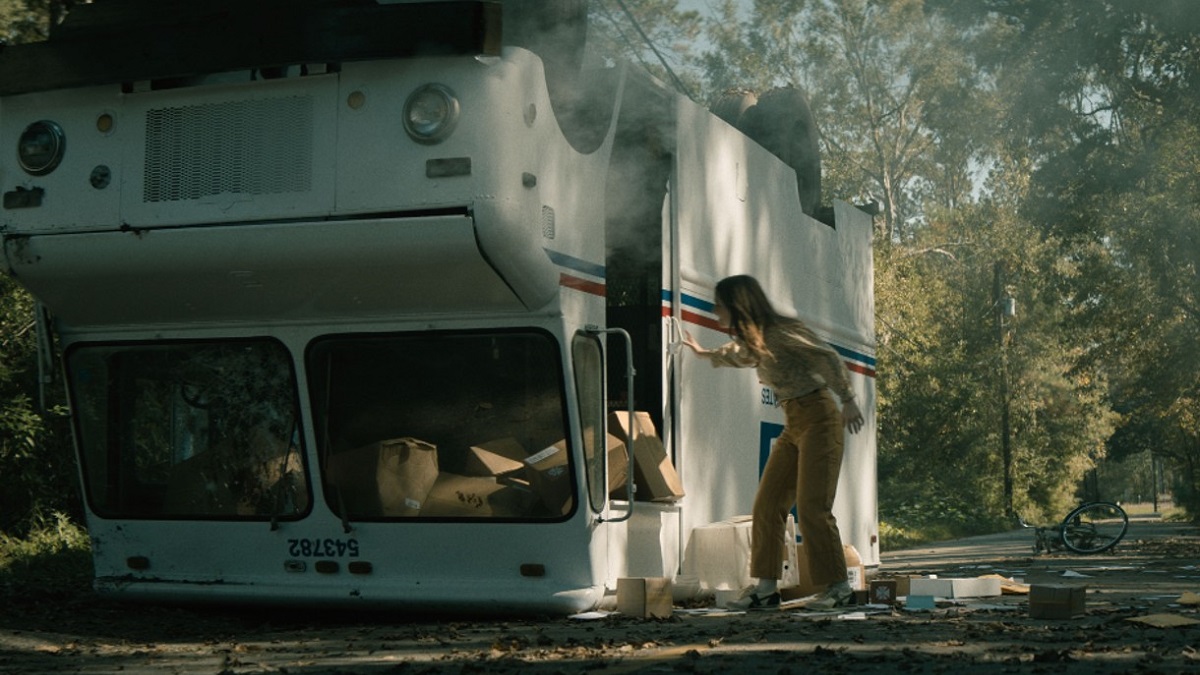
It’s the definitive alien in a way, but it’s become so embedded in pop culture that it’s almost being left behind as a result, except for maybe the occasional parody, which in a way enhances the atmosphere of the film because you’ve got the standard Gray popping up in this frantic thriller where they definitely do not want to be taken to your leader.
Brian Duffield: Right? Yeah, the way I kind of described it to people, like when initially the studio was like, “Are you sure you want to do the Grays?” and I I feel we get a dozen alien movies a year, and they’re all so so different. Like, this movie could not be more different than Landscape with Invisible Hand. But, that icon had been kind of missing from that.
And the way I told the studio is kind of like, if there was a dozen dinosaur movies a year, and none of them had a T-Rex for a decade. You’re kind of like, “Great, these are all amazing movies.” But at some point, I want the T Rex, you know? Even if it’s been the most popular forever, it just kind of felt like it got like a little abandoned. Everyone’s trying to do their own thing, and their own spin, that it felt like it was time to bring bring our boy home.
And then again, I think if we had gone in the more, for instance, the District 9 look, I think that opening 10 minutes of the movie, it could prove to be pretty confusing to people, if they’re getting glimpses of something that looks like a bug walking around, you can imagine people wondering what they were looking at. And so having something that was so clearly iconic, I think it just helped everyone, because we have a lot of narrative hoops to jump through. already, and so it just felt like having something like that was so clear. And so I’m on the same page, I know this felt like a real gift that, you know, it’s kind of bringing everyone in as opposed to making people ask questions, when I don’t want them to ask questions!
Because a lot of times when the movie is asking questions, and is demanding patience from both Brynn and the audience, in terms of figuring out mysteries or what motivations are, and I felt like being really specific about when that was a good question to ask. And when there wasn’t a question asked, being really blunt and being like, “Here’s an alien, it’s an alien, it looks like your emoji, now go.”
Exposition can often be the death of sci-fi, but it would be an understatement to say that you’re not going to find much of it in this movie. At the same time, you know everything you need to know and it’s easy to figure out the who, what, and why driving all of the major players. It’s “show don’t tell” cranked up to 10, but was that always one of your major driving forces from day one to sort of showcase that it’s possible to do lore, mythology, aliens, and action and do it well, without having to explain a thing?
Brian Duffield: Yeah, I mean, it’s fun. It’s one of the things we kind of learned is that if you’re not verbalizing exposition, you can’t be too blunt with it. So I think in terms of the spoon feeding, there’s quite a bit in there, it’s just not verbal, and so you don’t hear it the same way, I guess. But that was always really important to us both in terms of Brynn’s backstory, which is probably more complicated, more challenging to discern and wrap your head around.
And then what the aliens do. One of the things from the get-go for us was always not having Brynn get to turn on the TV and be like, “Oh, in Tennessee, there were lights over Nashville” kind of thing, which is a classic trope of movies like this, but it felt for me, the scariest thing is if Brynn can’t figure out what’s going on, and doesn’t understand what’s going on. And so she’s kind of putting the pieces together on her own, and doesn’t like the answer she’s coming up with. But it felt like, the lack of exposition, to me, made it scarier for her where she really wants someone to tell her what’s going on. Because I think there’s a little bit of safety when you know what’s going on. And like, is it confined to this town? What else is happening in the world? Is there a safe place to go to?
And so I think by taking out that exposition, it felt like she’s at such a loss. That makes it scarier, and especially when she is confronted by the aliens, they are talking to her nonstop. Like, they’re not trying to be quiet. And so it was always fun in the design and in the sound process to believe that, to go with the aliens are explaining exactly what’s happening to her, and she just can’t understand it, which is also maddening and scary for her. There’s a lot of exposition that she just isn’t receiving. As opposed to us being cheeky, it just kind of felt more like, “Oh, it’s scary if she really is working hard to figure out what’s going on and is not being given answers.”
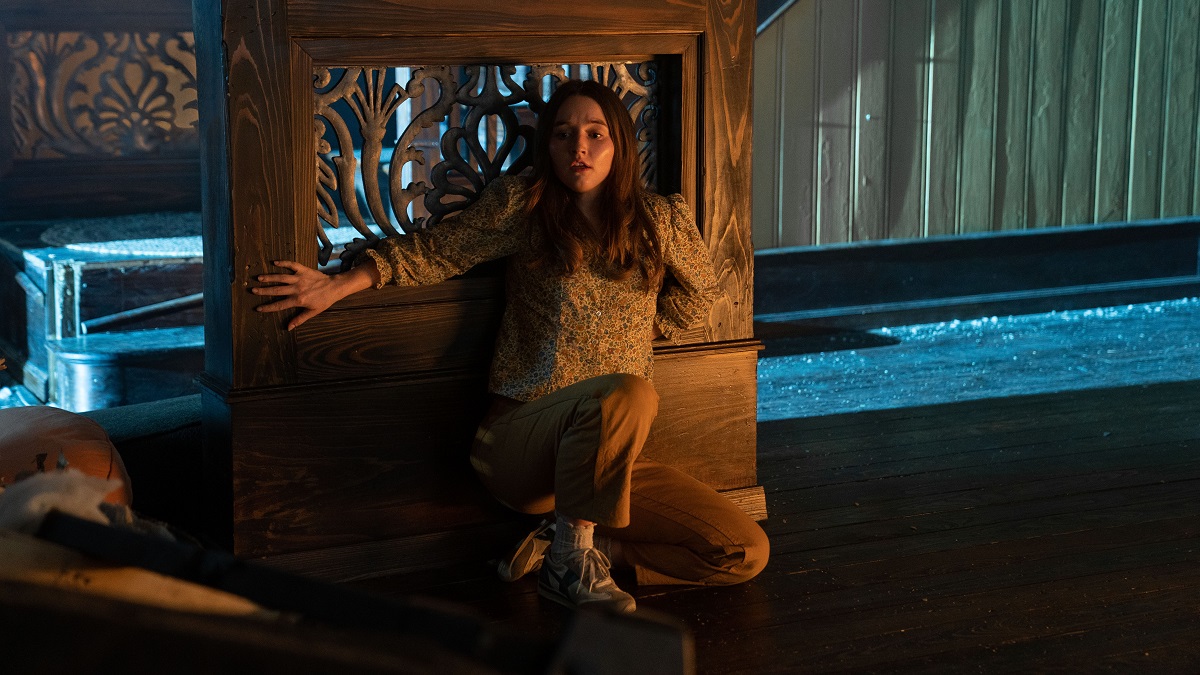
As a result, that puts even more focus on the sound design and the score in particular to enhance the experience. Presumably, that’s something you wanted to fine-tune to perfection, because both aspects are basically the second and third main characters in the movie.
Brian Duffield: Yeah. Oh, absolutely. Yeah, that was critical. Our score, I think, does So much heavy exposition lifting. We always would be very specific, there’s themes that when you hear the theme that’s very specific, it’s supposed to trigger memories of things that have happened earlier. Or connect worlds as it were.
And then the sound was really fun, to get to create this language with with our aliens, because that was one of the fun things about the iconic Grays is that they are usually silent. They don’t really talk. Even in Close Encounters, those aliens never speak. And so it felt like that was a really fun opportunity to get to design a language that wouldn’t be subtitled, but hopefully the audience and Brynn kind of pick up familiar sounds and dialects that she might not understand what they’re saying.
But there’s a familiar kind of pattern. So it was fun getting to talk about what they were saying with the post team, and then design it in a way that Kaitlyn’s character could kind of go “Okay, they’re saying that thing from earlier, I’m recognizing these different sounds that they’re saying.” So it’s not just, you know, clicks and whistles, there’s hopefully an intelligence there that you’re like, “Okay, these guys could have flown all the way here.” And then when they do walk in, they’re not expecting much of a challenge because they are so superior to everybody. So getting to play a little bit with that arrogance, too, is fun.
It both is and isn’t the movie that audiences might be expecting if all they’ve got to go on in the trailer, but embracing and subverting those tropes and trappings – sometimes in the space of the same scene – never feels unnatural or forced. It’s sounds like an oxymoron, and it’s intended as a huge compliment, but it feels like a love letter to classic sci-fi that ripped up the letter and threw it out as soon as it had been written.
Brian Duffield: Oh, sure! Yeah, I mean, I definitely am passionate about the genre. And I think it was less about ripping up the letter. If anything, it’s like trying to jam as many letters as possible in! Like I said about leaving it all on the field, I think there’s something really exciting about making a movie when you have to assume you won’t get to make another one.
And so, getting to make an alien movie, you’re kind of like, “Well, I don’t want to not have a flying saucer. I don’t not want to have these things.” Who knows if we’ll ever get back to make a second alien movie? It’s not that likely. Like, a lot of people don’t make two alien movies. And so it was just kind of like, “Okay, well, I have all these things I want to put in there.” And there are things that didn’t make it in, too, but it was kind of fun to build it out that way where it was like, “Okay, so what makes this situation worse for Brynn? At all times?”
And certainly, the flying saucers are really good example of that, that’s not in the trailer. But I think everyone assumes, you know, gray Alien UFO kind of thing. I really wanted a UFO. And that was fun to subvert the UFO, like we do. But also, it was great, because the first time Caitlin sees the UFO, she kind of instantly understands what the threat of the UFO is, because of iconography. So without being told what it can do, as soon as she sees it, she starts losing her shit, because she knows.
And based on things that have happened earlier in the movie, you know, the light beam is going to come down. So getting to play with what the audience knows going in, and giving them what they know going in, and then getting to subvert it a little bit actually, like you said about the exposition, it helps. When Kaitlyn’s freaking out everyone goes, “This is the problem with this UFO that we’ve never seen before.” But as soon as we see it, we understand what is at stake. And what Kaitlyn needs to do to get out of there. And so that just felt like a fun thing, that your your exposition is kind of the last 100 years of movies, as opposed to a character having to do too much.
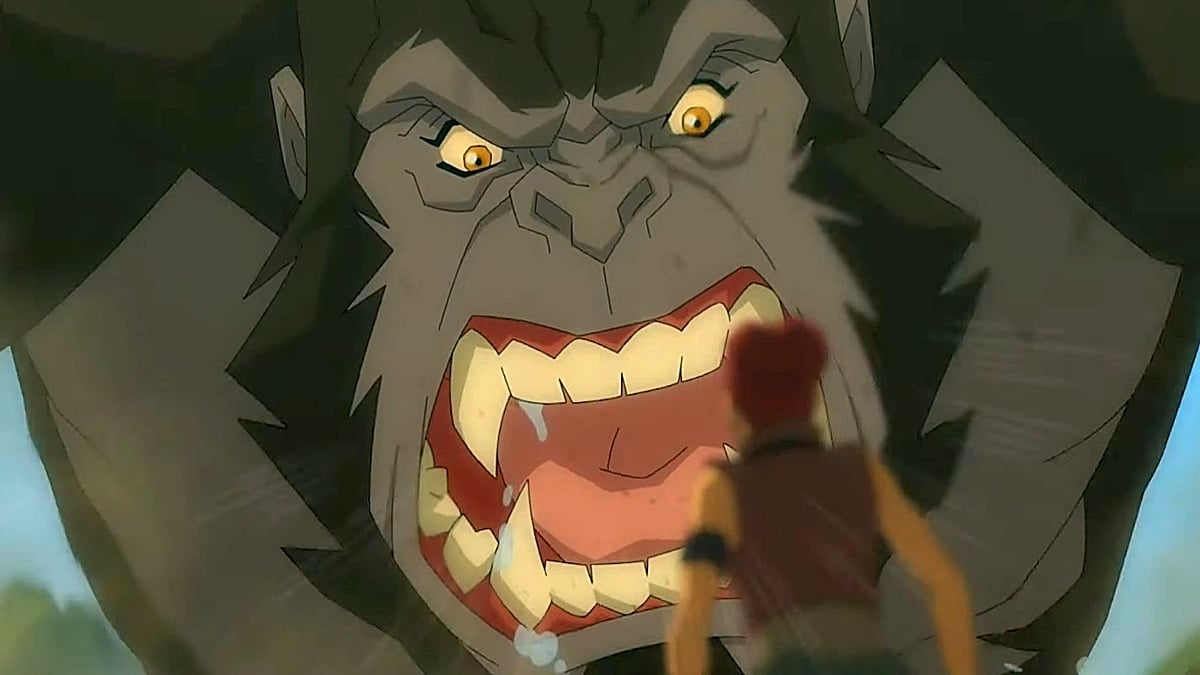
You recently dived into the world of animation with Skull Island on Netflix, which is of course a series focusing on one of the most iconic monsters there’s ever been. You’ve done kaiju and Grays with your most recent projects, but are there any other classics, legends, icons, or IPs you’d love to get your hands on one day?
Brian Duffield: Yeah, I mean, just because I’ve been vocal about this after Skull Island, is that I’ve been really pushing to do an animated Godzilla movie. I don’t know if it’ll happen or not. But my hunch is it probably won’t, because it’s pretty out there. But that was one where I thought, “I have a really good idea for an animated Godzilla movie that I really would love to do.” And I’ve talked to Legendary about it, because I have the relationship I have with them after Skull Island.
But we’ll see if it if it happens or not. I don’t think it will. Well, who knows? But that’s one that it’s like, it’s Godzilla. In 20 years, I could wind up doing it, too. So I have a very specific Godzilla thing I wanted to do an animated movie for, but that’s more or less the only only thing I’d say. I like playing in my own sandbox usually. So I don’t dip my toes into other things too often, but I had a really great experience on on Skull Island. And I’d love to do more with those guys.
Godzilla exempt, then, if you could make any project of your choosing however you want to make it, what would be at the top of your list?
Brian Duffield: Oh, I have… I can’t say what, it’s original. But I have a movie that I’ve been working on with my friends at Lord/Miller. That’s kind of a bigger fantasy-esque kind of thing. So my answer would be that. That would be really fun. It’s really big and unique. But that would be really, that would be the one that I’m like, “Oh, I could retire after that one,” kind of.
No One Will Save You premieres on Hulu this Friday, Sept. 22.
Denial of responsibility! My Droll is an automatic aggregator of Global media. In each content, the hyperlink to the primary source is specified. All trademarks belong to their rightful owners, and all materials to their authors. For any complaint, please reach us at – [email protected]. We will take necessary action within 24 hours.

